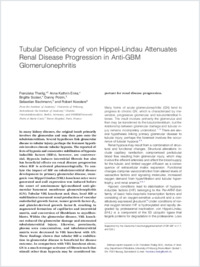Tubular deficiency of von Hippel-Lindau attenuates renal disease progression in anti-GBM glomerulonephritis
- Theilig, Franziska Institute of Anatomy, University of Fribourg, Switzerland - Institute of Anatomy, Charité-Universitätsmedizin, Berlin, Germany
- Enke, Anne Kathrin Institute of Anatomy, University of Fribourg, Switzerland
- Scolari, Brigitte Institute of Anatomy, University of Fribourg, Switzerland
- Polzin, Danny Institute of Anatomy, Charité-Universitätsmedizin, Berlin, Germany
- Bachmann, Sebastian Institute of Anatomy, Charité-Universitätsmedizin, Berlin, Germany
- Koesters, Robert INSERM/Université Pierre et Marie Curie, Tenon Hospital, Paris, France
-
15.09.2011
Published in:
- The American Journal of Pathology. - 2011, vol. 179, no. 5, p. 2177–2188
English
In many kidney diseases, the original insult primarily involves the glomerulus and may then pass onto the tubulointerstitium. Several hypotheses link glomerular disease to tubular injury; perhaps the foremost hypothesis involves chronic tubular hypoxia. The reported effects of hypoxia and consecutive stabilization of hypoxia-inducible factors (HIFs), however, are controversial. Hypoxia induces interstitial fibrosis but also has beneficial effects on renal disease progression when HIF is activated pharmacologically. To analyze the impact of HIF on tubulointerstitial disease development in primary glomerular disease, transgenic von Hippel Lindau (VHL)-knockout mice were generated and null expression was induced before the onset of autoimmune IgG-mediated anti–glomerular basement membrane glomerulonephritis (GN). Tubular VHL knockout and, thus, local HIF-α stabilization increased renal production of vascular endothelial growth factor, tumor growth factor–β₁, and platelet-derived growth factor-B, resulting in augmented formation of capillaries and interstitial matrix, and conversion of fibroblasts to myofibroblasts. Within the glomerular disease, VHL knockout reduced the glomerular damage and attenuated tubulointerstitial injury. Likewise, proteinuria, plasma urea concentration, and tubulointerstitial matrix were decreased in VHL knockout with GN. These findings shown that tubular HIF-α stabilization in glomerular disease is beneficial for disease outcome. In comparison with VHL knockout alone, GN is a much stronger activator of fibrosis such that stimuli other than hypoxia may be considered important for renal disease progression.
- Faculty
- Faculté des sciences et de médecine
- Department
- Département de Médecine
- Language
-
- English
- Classification
- Biological sciences
- License
-
License undefined
- Identifiers
-
- RERO DOC 28284
- DOI 10.1016/j.ajpath.2011.07.012
- Persistent URL
- https://folia.unifr.ch/unifr/documents/302255
Statistics
Document views: 92
File downloads:
- pdf: 202
